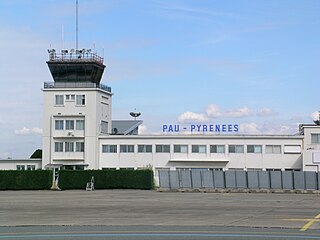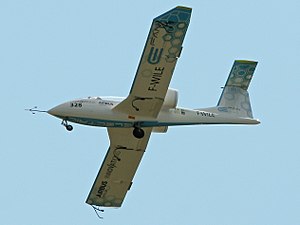
The Colomban Cri-Cri, also spelled Cricri, is the smallest twin-engined manned aircraft in the world, designed in the early 1970s by French aeronautical engineer Michel Colomban.
SOCATA was a French producer of general aviation aircraft propelled by piston engines and turboprops, including business planes, small personal or training aircraft, as well as the production of aircraft structures for other manufacturers such as Airbus, Dassault, Embraer, Eurocopter and Lockheed Martin. The company had its headquarters, along with much of its production capabilities, located in Tarbes, France.

The SOCATA TBM is a family of high-performance single-engine turboprop business and utility light aircraft manufactured by Daher. It was originally collaboratively developed between the American Mooney Airplane Company and French light aircraft manufacturer SOCATA.

Pau Pyrénées Airport is an airport serving Pau, France. It is located 10 km (6.2 mi) northwest of Pau in Uzein, a commune of the département of Pyrénées-Atlantiques.

An electric aircraft is an aircraft powered by electricity. Electric aircraft are seen as a way to reduce the environmental effects of aviation, providing zero emissions and quieter flights. Electricity may be supplied by a variety of methods, the most common being batteries. Most have electric motors driving propellers or turbines.
VoltAir is a wholly owned subsidiary of Airbus which is developing a proposed electrically powered airliner that was publicly announced in 2011. The preliminary concept drawings released at that time showed a low unswept wing on a conventional small-diameter fuselage. A large duct at the fuselage's rear contains two counter-rotating propellers, which would be driven by two large electric motors. Power would be supplied by a lithium-air battery pack mounted in a detachable pod on the lower fuselage nose, where it could be removed and replaced as part of the normal airport turnaround process in passenger-carriage service.
Pipistrel d.o.o Ajdovščina is a Slovenian light aircraft manufacturer established in 1989 by Ivo Boscarol and based in Ajdovščina. Its facilities are located in Ajdovščina, Slovenia, and near the town of Gorizia, Italy. By March 2019, Pipistrel had produced more than 2000 aircraft.

Daher is a French industrial conglomerate. It is operational across the aerospace, defence, nuclear, and automotive industrial sectors in the fields of manufacturing, services, and transport.

The Pipistrel Alpha Trainer is a Slovenian two-seat, single-engine light-sport aircraft intended specifically for flight training, designed and produced by Pipistrel in Gorizia, Italy.

The Bye Aerospace eFlyer 2 is a light electric aircraft designed and under development by Bye Aerospace of Denver, Colorado.

The NASA X-57 Maxwell was an experimental aircraft being developed by NASA, intended to demonstrate technology to reduce fuel use, emissions, and noise. The first flight of the X-57 was scheduled to take place in 2023, but the program was cancelled due to problems with the propulsion system.

The Lilium Jet is a prototype German electric vertical take-off and landing (eVTOL) electrically powered airplane designed by Lilium GmbH. A seven-seat production version is planned.

The Eviation Alice is an electric aircraft designed to accommodate nine passengers and two crew members. Currently under development, its construction incorporates 95% composite material, is powered by two electric motors, and has a T-tail. The prototype first flew on 27 September 2022.
The Airbus/Rolls-Royce/Siemens E-Fan X was a hybrid electric aircraft demonstrator being developed by a partnership of Airbus, Rolls-Royce plc and Siemens. Announced on 28 November 2017, it followed previous electric flight demonstrators towards sustainable transport for the European Commission’s Flightpath 2050 Vision. A BAe 146 flying testbed was to have one of its four Lycoming ALF502 turbofans replaced by a Siemens 2 MW (2,700 hp) electric motor, adapted by Rolls-Royce and powered by its AE2100 turboshaft, controlled and integrated by Airbus with a 2 t (4,400 lb) battery. In April 2020, the programme was cancelled during the COVID-19 pandemic.
Bye Aerospace is an American aircraft manufacturer based in unincorporated Arapahoe County, Colorado. The company specializes in the design and manufacture of electric aircraft, including unmanned aircraft for geospatial role and light aircraft for the flight training role. The company was founded by George E. Bye, who remains the CEO.

The Volocopter 2X is a German two-seat, optionally-piloted, multirotor eVTOL aircraft. The personal air vehicle was designed and produced by Volocopter GmbH of Bruchsal, and first introduced at the AERO Friedrichshafen airshow in 2017. The aircraft is sold complete and ready-to-fly. Volocopter was formerly known as E-volo.

The Opener BlackFly is an American electric-powered VTOL personal air vehicle designed by Canadian engineer Marcus Leng. It was publicly revealed in 2018, after nine years of development. The aircraft is intended to be supplied complete and ready-to-fly and Opener are in the process of starting production at their Palo Alto, California site.

The VoltAero Cassio is a family of hybrid electric aircraft being developed by startup company VoltAero. The company plans to produce three configurations of the Cassio aircraft: the four-place Cassio 330, the six-place Cassio 480, and the ten-place Cassio 600.
A hybrid electric aircraft is an aircraft with a hybrid electric powertrain. As the energy density of lithium-ion batteries is much lower than aviation fuel, a hybrid electric powertrain may effectively increase flight range compared to pure electric aircraft. By May 2018, there were over 30 hybrid electric aircraft projects, and short-haul hybrid-electric airliners were envisioned from 2032.















